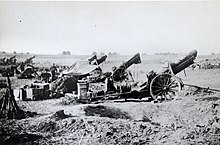
Back Schlacht bei Soissons (1918) German Batalla de Soissons (1918) Spanish Soissonsko gudua (1918) Basque Bataille du Soissonnais French Battaglia di Soissons (1918) Italian Trận Soissons (1918) Vietnamese 蘇瓦松戰役 (1918年) Chinese
| Battle of Soissons | |||||||
|---|---|---|---|---|---|---|---|
| Part of the Second Battle of the Marne, Western Front of World War I | |||||||
 American heavy artillery at Soissons, 1918 | |||||||
| |||||||
| Belligerents | |||||||
|
| |||||||
| Commanders and leaders | |||||||
| |||||||
| Strength | |||||||
| At least 345,000 men, 478 tanks | At least 234,000 men, 210 aircraft | ||||||
| Casualties and losses | |||||||
| |||||||
The Battle of Soissons (1918) (also known as the Battle of the Soissonnais and of the Ourcq (French: Bataille du Soissoinais et de L'Ourcq)[a]) was fought on the Western Front during World War I. Waged from 18 to 22 July 1918 between the French (with American and British assistance) and the German armies, the battle was part of the much larger Allied Aisne-Marne counter-offensive. It followed the final German Spring Offensive, Operation Marneschutz-Reims (also known as the Friedensturm or peace offensive). The primary objective of the attack was to cut both the Soissons – Château-Thierry road and the railroad running south from Soissons to Château-Thierry. As these were the main supply routes for the German forces in the Marne salient, cutting them would severely impair the Germans' ability to supply its armies defending it. This would force them to retreat and give up their gains.[4][5] This battle marked the turning point of the war as the Germans would be on the defensive for the remainder of the conflict.[3][6]
- ^ a b firstworldwar.com n.d.
- ^ Venzon 1995, p. 566
- ^ a b Zabecki 2014a, p. 29
- ^ United States Army, Center of Military History 1992b, p. 218
- ^ Nelson 2009, p. 182
- ^ United States Army, Center of Military History 1992a, p. 30
Cite error: There are <ref group=lower-alpha> tags or {{efn}} templates on this page, but the references will not show without a {{reflist|group=lower-alpha}} template or {{notelist}} template (see the help page).
© MMXXIII Rich X Search. We shall prevail. All rights reserved. Rich X Search